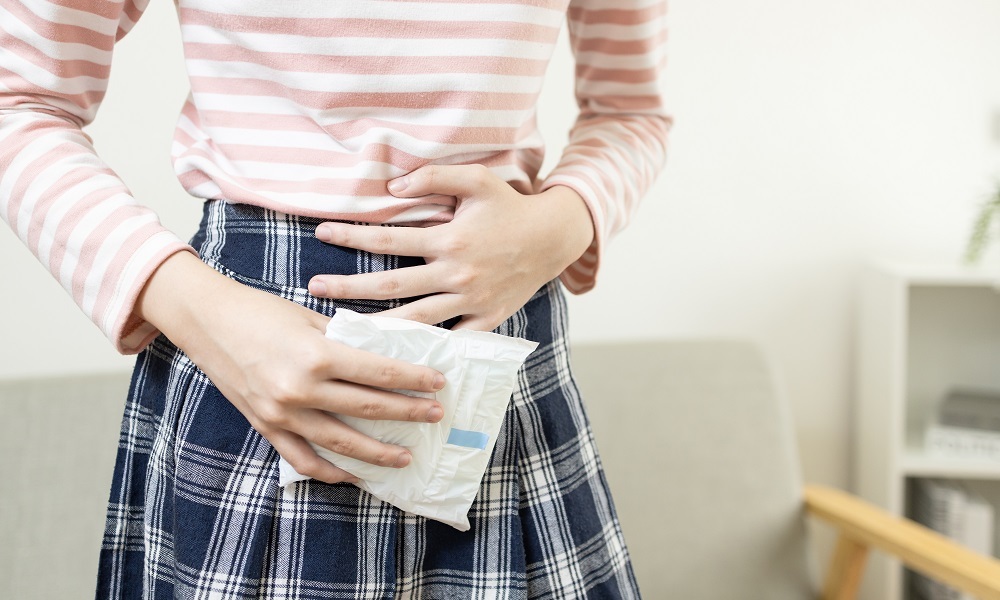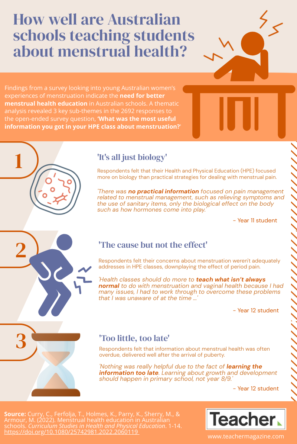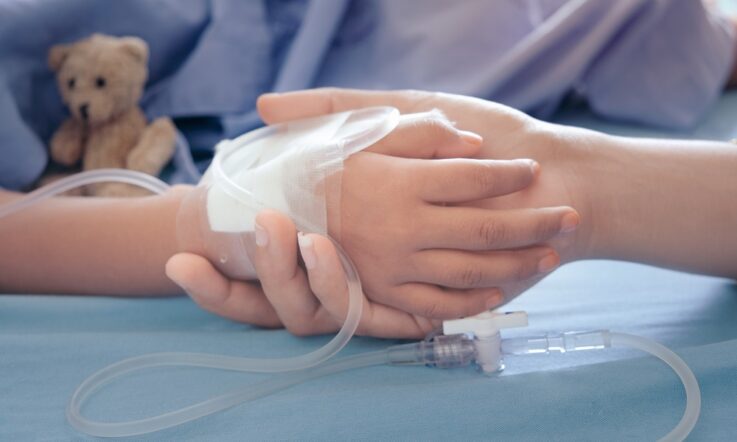While menstrual health education is indirectly part of the Australian Health and Physical Education curriculum, it is not currently mandated for schools to teach students about menstrual health, leaving many students unsure of how to manage pain effectively and many teachers unaware of how this can impact students’ education.
Dr Christina Curry, a senior lecturer at Western Sydney University and former HPE teacher, is the lead author of an article recently published in the Curriculum Studies in Health and Physical Education journal. In the article, Dr Curry and her colleagues explore some of the findings from a larger survey which indicated the need for better menstrual health education in Australian schools.
‘We undertook quite a large survey in 2017 to 2018 with 4,202 participants between the ages of 13 and 25,’ Dr Curry tells Teacher. ‘So this particular paper is part of the qualitative part of that survey which asked the question, “What was the most useful information about menstruation received in HPE class?”’
The research findings
A thematic analysis revealed 3 key sub-themes in the 2692 responses to the open-ended survey question:
- the information students received in HPE classes about menstruation was ‘all just biology’ rather than practical information for pain management
- students were taught more about ‘the cause but not the effect’ of menstrual pain, leaving them unsure about what is ‘normal’ and when and how to seek medical help
- menstrual health education came ‘too little, too late’, reaching students years after the beginning of puberty
‘When you look at the curriculum, it addresses the physical, social and emotional changes, including how the body changes as people grow. So that’s from Foundation to Year 2, and then from Year 3 to 10, it addresses puberty and how the body changes over time.’ Dr Curry explains.
‘Specifically in Years 5 to 8, there’s a focus on puberty and physical changes while then in Year 9, the syllabus shifts more to sexuality and sexual health. So therefore, menstruation can be taught early on in school education because of these changes in curriculum.’
Interestingly, of the 2692 responses to this question, 6.9% of students reported receiving no information about menstruation in their schooling, and 14% felt they did not learn anything perceived to be useful.
The misconceptions about menstrual pain in schools
Because period pain is so common for young people who menstruate, there can be a common misconception that this pain is normal and manageable, with little impact on students’ education.
‘There has been a view in the past of, “it’s just normal, you’ll be alright”. It’s hasn’t been considered in a way where it can have huge impacts on some young people who are menstruating,’ says Dr Curry.
While there has been a gap in the research for some time, recent research has started to address the impacts of menstrual pain on young people’s education, including attendance, concentration in class and physical participation in sport. Dr Curry explains that it’s important to have a whole-school approach and awareness when it comes to supporting students.
‘If there’s a student who is experiencing pain, and can’t concentrate due to this pain, I think it is important that all teachers are aware that it is a health issue, and it has impacts. And this can easily be misinterpreted as not being engaged or not wanting to participate.’
How can schools better support students and teachers in their menstrual health education?
When it comes to practical strategies to provide informed menstrual health education in schools, Dr Curry emphasises that it is important for both students and teachers to be able to access accurate information.
‘Just getting the right information is key – and that’s another thing our research found, that a lot of young people just revert to Google, and where you land on Google – who knows?’
Another challenge for students can be navigating the taboos and stigmas with speaking about menstrual pain in some cultures or households. ‘So sometimes the only place they’re going to learn about it is through school.’
There are important practical steps for schools to take here, including, Dr Curry says, ‘building staff confidence and competence, the roles of boys and men in menstrual health as well, involvement of counsellors where the school has a support worker or nurse, or the year advisers.’
Part of providing students with quality menstrual health education, however, is to also address stigmas which can sometimes exist for teachers.
‘Part of it is how you encourage people to be more comfortable to speak about it. And sometimes that’s something that individual teachers need to work through as well, but with resources and materials that allow them to address that appropriately.
‘Because teachers are busy, and there’s just so much content. So to provide it in a way where it’s clear what the important things to teach are and why, and then how to do that, and being conscious of that holistic approach is key – that it does impact other areas for these young people in schools.’
References and further reading:
Curry, C., Ferfolja, T., Holmes, K., Parry, K., Sherry, M., & Armour, M. (2022). Menstrual health education in Australian schools. Curriculum Studies in Health and Physical Education. https://www.tandfonline.com/doi/full/10.1080/25742981.2022.2060119
Dr Curry and her research team have created a resource with information and resources on menstrual pain which can be accessed freely here.
As a HPE teacher, how do you teach menstrual health education in your classroom? How can you incorporate the research explored in this article into your classroom practice?
As a teacher, how familiar are you with the impacts of period pain, and how can you support students to manage this pain and the impact it may have on their education?



